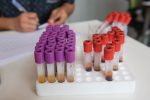Juvenile idiopathic arthritis or JIA, the most frequent chronic inflammatory arthritis disorder affecting children, may co-occur with Fabry disease, according to a study of children with JIA in Brazil.
While early Fabry symptoms may resemble those of JIA — and may lead to misdiagnoses — in this study, researchers reported rare cases where both conditions were present.
In addition, several mutations of unknown significance in the Fabry disease-causing GLA gene were found in these JIA patients, and were significantly associated with Fabry-like symptoms.
These findings suggest that pediatric rheumatologists should not only be aware of Fabry disease and its potential similarities with juvenile idiopathic arthritis, but that they should also consider the possibility of their co-existence, the researchers noted.
The data also highlight the need for further research on these GLA variants to clarify their clinical relevance.

The study, “Frequency of Fabry disease in a juvenile idiopathic arthritis cohort,” was published in the journal Pediatric Rheumatology.
Fabry is caused by the absent or markedly reduced activity of the alpha-galactosidase A (Gal A) enzyme due to mutations in the GLA gene. Gal A deficiency leads to the toxic buildup of fatty molecules in tissues and organs, promoting inflammation and damaging function.
Given that female patients, who typically show milder disease than male patients, may have Gal A activity within the normal range, standard Gal A enzymatic testing does not provide an accurate diagnosis of Fabry disease, the researchers said. Thus, genetic testing should be performed, they said.
The disease should be suspected in individuals presenting classic symptoms, such as burning, tingling, or pricking sensations in the hands and feet, clusters of small, reddish or dark-blue spots on the skin (angiokeratomas), gastrointestinal problems, exercise intolerance, eye abnormalities, decreased sweating, and kidney and heart involvement.
However, classic Fabry symptoms are rare during childhood, and patients may only experience mild, non-specific symptoms affecting the musculoskeletal system, such as pain in the hands and feet and arthritis, specifically joint inflammation and swelling.
While this may lead clinicians to incorrectly diagnose Fabry disease for JIA, the most common inflammatory arthritis in children, the frequency of Fabry among JIA patients remains unknown.
Now, researchers in Brazil set out to assess Fabry’s frequency among 89 children — 50 girls and 49 boys — diagnosed with juvenile idiopathic arthritis and followed at a single center. The children had a mean age of 8.9 at disease onset. The assessment was done by evaluating early symptoms, and conducting enzymatic and/or genetic testing.
All female participants underwent genetic testing for GLA mutations, while GLA activity was assessed in 79.6% of all boys (39 boys), of whom four showed lower enzyme activity and subsequently underwent genetic testing. Genetic testing was performed in a total of 54 children (60.7%).

The results showed that several clinical symptoms associated with Fabry disease were present in these children. Almost half described burning or tingling sensations in the hands and/or feet, a third had weight-gain difficulty, and nearly one-quarter showed heart abnormalities. Also, 42% had a history of stroke in the family.
However, “all these features could be associated with chronic arthritis and its treatment,” the researchers wrote.
Notably, four boys had slightly reduced Gal A activity, of whom one (1.1%) carried a known disease-causative GLA mutation (c.1244 T >C; p.L415P). The boy had several symptoms suggestive of Fabry at age 5, such as hands and feet burning pain, exercise intolerance, and sweating and gastrointestinal problems.
At the age of 11, he complained of ankle pain and swelling, and subsequent examination by a pediatric rheumatologist also revealed angiokeratomas around the belly bottom. He also was found to have heart and eye abnormalities. The boy also had a history of serious cardiovascular events in family members younger than 50.
After a genetic confirmation of Fabry disease, the boy started enzyme replacement therapy (ERT) and his Fabry symptoms lessened. However, his arthritis was only resolved with standard immunosuppressive treatment typically used in JIA.
In addition, one girl was found to have a previously unreported GLA mutation of uncertain significance (c.38C > T; p.Ala13Val), and another girl carried a known mutation (c.48 T > G; p.Leu16Leu) considered likely harmless, or non-disease-causative.
The newly identified mutation was predicted to be harmless, but the girl reported burning or tingling sensations in the hands and/or feet, weight gain difficulties, and Fabry-associated eye abnormalities. Her mother had an early stroke, but tested negative for GLA mutations.
Interestingly, 44.4% of the children tested for GLA mutations carried variations in the gene’s introns, the DNA sections that do not provide instructions for protein production. Six intronic mutations were identified, and four were found at a higher frequency than in the general population, the researchers said.
These variants, as well as their combination — known as a complex intronic haplotype (CIH) — were significantly associated with Fabry symptoms in these children.
Specifically, eight children, including the boy with Fabry and the girl with the mutation of unknown significance, shared the same CIH (c.-10C > T, c.370-77_-81del, c.640-16A > G, c.1000-22C > T). This CIH was previously linked to Fabry, even in the absence of known disease-causative mutations.
These findings highlighted the presence of Fabry in 1.1% of JIA patients, suggesting that “pediatric rheumatologists should be aware that FD [Fabry disease] could present with similar classic autoimmune disease features, but they can also co-exist,” the researchers wrote.
“Screening for FD in JIA may be a reasonable strategy for those with an atypical pattern of pain,” the team wrote, adding that the presence of other symptoms suggestive of Fabry and a family history of early cardiovascular events should prompt further testing.
"occur" - Google News
September 04, 2021 at 03:02AM
https://ift.tt/38H6lKq
Juvenile Idiopathic Arthritis, Fabry Found to Co-occur in Children - Fabry Disease News
"occur" - Google News
https://ift.tt/2UoDqVw
https://ift.tt/2Wq6qvt
Bagikan Berita Ini
















0 Response to "Juvenile Idiopathic Arthritis, Fabry Found to Co-occur in Children - Fabry Disease News"
Post a Comment